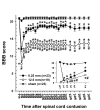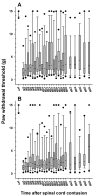Long-term Follow-up of Cutaneous Hypersensitivity in Rats with a Spinal Cord Contusion
- PMID: 19967071
- PMCID: PMC2788651
- DOI: 10.4196/kjpp.2008.12.6.299
Long-term Follow-up of Cutaneous Hypersensitivity in Rats with a Spinal Cord Contusion
Abstract
Sometimes, spinal cord injury (SCI) results in various chronic neuropathic pain syndromes that occur diffusely below the level of the injury. It has been reported that behavioral signs of neuropathic pain are expressed in the animal models of contusive SCI. However, the observation period is relatively short considering the natural course of pain in human SCI patients. Therefore, this study was undertaken to examine the time course of mechanical and cold allodynia in the hindpaw after a spinal cord contusion in rats for a long period of time (30 weeks). The hindpaw withdrawal threshold to mechanical stimulation was applied to the plantar surface of the hindpaw, and the withdrawal frequency to the application of acetone was measured before and after a spinal contusion. The spinal cord contusion was produced by dropping a 10 g weight from a 6.25 and 12.5 mm height using a NYU impactor. After the injury, rats showed a decreased withdrawal threshold to von Frey stimulation, indicating the development of mechanical allodynia which persisted for 30 weeks. The withdrawal threshold between the two experimental groups was similar. The response frequencies to acetone increased after the SCI, but they were developed slowly. Cold allodynia persisted for 30 weeks in 12.5 mm group. The sham animals did not show any significant behavioral changes. These results provide behavioral evidence to indicate that the below-level pain was well developed and maintained in the contusion model for a long time, suggesting a model suitable for pain research, especially in the late stage of SCI or for long term effects of analgesic intervention.
Keywords: Central neuropathic pain; Cold allodynia; Mechanical allodynia; Spinal cord contusion; Spinal cord injury.
Figures






Similar articles
-
Mechanical and cold allodynia in a rat spinal cord contusion model.Somatosens Mot Res. 2004 Mar;21(1):25-31. doi: 10.1080/0899022042000201272. Somatosens Mot Res. 2004. PMID: 15203971
-
Strain and model differences in behavioral outcomes after spinal cord injury in rat.J Neurotrauma. 2001 Aug;18(8):743-56. doi: 10.1089/089771501316919111. J Neurotrauma. 2001. PMID: 11526981
-
Administration of ONO-2506 suppresses neuropathic pain after spinal cord injury by inhibition of astrocytic activation.Spine J. 2019 Aug;19(8):1434-1442. doi: 10.1016/j.spinee.2019.04.006. Epub 2019 Apr 8. Spine J. 2019. PMID: 30974239
-
Animals models of spinal cord contusion injury.Korean J Pain. 2019 Jan;32(1):12-21. doi: 10.3344/kjp.2019.32.1.12. Epub 2019 Jan 2. Korean J Pain. 2019. PMID: 30671199 Free PMC article. Review.
-
The biomechanical implications of neck position in cervical contusion animal models of SCI.Front Neurol. 2023 Jun 6;14:1152472. doi: 10.3389/fneur.2023.1152472. eCollection 2023. Front Neurol. 2023. PMID: 37346165 Free PMC article. Review.
Cited by
-
Low-Level Laser Irradiation Improves Motor Recovery After Contusive Spinal Cord Injury in Rats.Tissue Eng Regen Med. 2017 Jan 17;14(1):57-64. doi: 10.1007/s13770-016-0003-4. eCollection 2017 Feb. Tissue Eng Regen Med. 2017. PMID: 30603462 Free PMC article.
-
Panax ginseng Improves Functional Recovery after Contusive Spinal Cord Injury by Regulating the Inflammatory Response in Rats: An In Vivo Study.Evid Based Complement Alternat Med. 2015;2015:817096. doi: 10.1155/2015/817096. Epub 2015 Sep 15. Evid Based Complement Alternat Med. 2015. PMID: 26451158 Free PMC article.
-
Acrolein as a novel therapeutic target for motor and sensory deficits in spinal cord injury.Neural Regen Res. 2014 Apr 1;9(7):677-83. doi: 10.4103/1673-5374.131564. Neural Regen Res. 2014. PMID: 25206871 Free PMC article.
-
Application of the Rat Grimace Scale as a Marker of Supraspinal Pain Sensation after Cervical Spinal Cord Injury.J Neurotrauma. 2017 Nov 1;34(21):2982-2993. doi: 10.1089/neu.2016.4665. Epub 2017 Jun 26. J Neurotrauma. 2017. PMID: 27998207 Free PMC article.
-
Abnormal feeding behaviour in spinalised rats is mediated by hypothalamus: Restorative effect of exposure to extremely low frequency magnetic field.Spinal Cord. 2016 Dec;54(12):1076-1087. doi: 10.1038/sc.2016.32. Epub 2016 May 10. Spinal Cord. 2016. PMID: 27163452
References
-
- Basso DM, Beattie MS, Bresnahan JC. A sensitive and reliable locomotor rating scale for open field testing in rats. J Neurotrauma. 1995;12:1–21. - PubMed
-
- Basso DM, Beattie MS, Bresnahan JC. Graded histological and locomotor outcomes after spinal cord contusion using the NYU weight-drop device versus transection. Exp Neurol. 1996a;139:244–256. - PubMed
-
- Basso DM, Beattie MS, Bresnahan JC, Anderson DK, Faden AI, Gruner JA, Holford TR, Hsu CY, Noble LJ, Nockels R, Perot PL, Salzman SK, Young W. MASCIS evaluation of open field locomotor scores: effects of experience and teamwork on reliability. Multicenter Animal Spinal Cord Injury Study. J Neurotrauma. 1996b;13:343–359. - PubMed
-
- Behrmann DL, Bresnahan JC, Beattie MS. Modeling of acute spinal cord injury in the rat: neuroprotection and enhanced recovery with methylprednisolone, U-74006F and YM-14673. Exp Neurol. 1994;126:61–75. - PubMed
-
- Beric A. Central pain: "new" syndromes and their evaluation. Muscle Nerve. 1993;16:1017–1024. - PubMed

